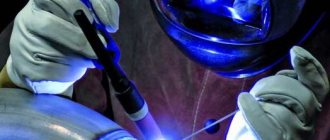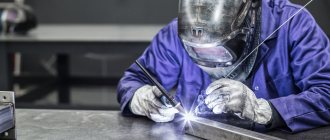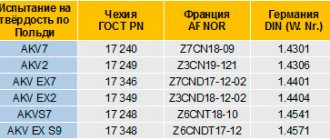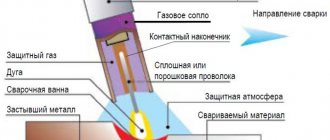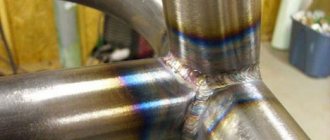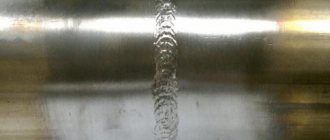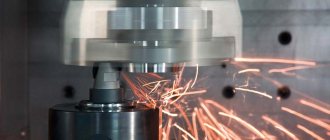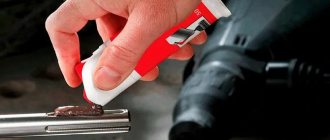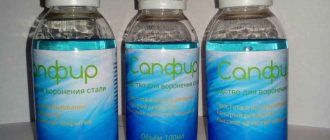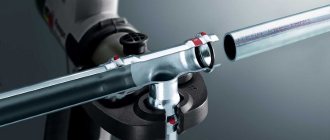- Home page
- •
- Articles on welding
- •
- Welding stainless steel with an electrode
Let's consider all possible options for welding stainless steel and talk in more detail about the MMA method
Steel alloyed with chromium and nickel is called stainless steel because it successfully resists corrosion. Due to this, the metal is actively used for containers and pipelines with liquids. Protective arches for SUV bumpers and running boards designed for wet environments are made from stainless steel. If you need to weld a crack or make a joint, you can use an MMA inverter, but there are other options. Let's consider all the possibilities and talk in more detail about RDS welding of stainless steel.
In this article:
It is carried out using a direct current source (inverter, rectifier, welding generator). The welder operates a holder with a consumable electrode. The electrode rod acts as a filler material, and its coating protects the weld pool from the external environment.
This is the most budget option that does not require expensive welding equipment. Consumables for it are also available. But the quality of the seams is far from ideal, although the connections can be airtight.
Manual argon tungsten electrode (TIG)
This is done using a DC source to which two cables are connected. One is the mass, and the second leads to the burner. The torch nozzle contains a tungsten electrode. It doesn't melt, so it doesn't shorten. It is easier for the welder to maintain a stable arc height, the seam is smoother, narrower, and smoother. The filler metal is additionally supplied by the welder’s second hand. The weld pool is protected by inert gas coming out of the torch nozzle.
The seams when TIG welding stainless steel are of better quality, but the process is slow. Consumables (tungsten electrodes, gas) are expensive. The equipment also differs in price from MMA to a greater extent.
Semi-automatic wire welding (MIG)
Semi-automatic welding uses direct current equipment and a feed mechanism. He pushes a wire protruding as a consumable electrode. But the length of the wire coming out of the torch nozzle remains constant, so it is easier to control the height of the arc. To protect the weld pool, gas is used, supplied from a cylinder with a reducer through a valve in the welding machine.
Semi-automatic stainless steel welding is the most productive, but is inferior in seam quality to the TIG method. Consumables for this welding method are more expensive than for RDS.
Features of stainless steel welding
When welding stainless steel with electrodes, there are certain difficulties that lead to weld defects if the process is not completed with the necessary consumables and in the correct mode. One of the problems is the increased linear expansion of alloy steel when heated. After cooling, cracks are possible in the seam. To prevent this, it is important to use electrodes that contain elastic additives that increase the plasticity of the connection and endurance under dynamic loads.
Increased linear expansion leads to deformation from heating, so it is better to make long seams in a checkerboard pattern. If these are continuous seams on a large container, then they are applied sequentially, starting from the end of the connection line. Welding is carried out in segments 10 cm long. Each new seam ends at the beginning of the previous one. Then the plane will move less.
Another difficulty is the burnout of alloyed elements. When exposed to a welding arc, chromium and nickel burn out from the base metal, so the seams on stainless steel begin to become covered with brown dots and leak. To combat this, the filler metal must contain even more alloying elements to compensate for the burnt-out ones. Then the seams will have the same composition as the base metal.
Another difficulty is the interaction of carbon from steel with oxygen that has penetrated into the weld pool. Their reaction causes seething, it is difficult to control the arc, and frozen open and closed pores are possible in the seam. Such a joint will not be airtight. To prevent a reaction between carbon and oxygen, the weld pool must be well protected by gases from the melting coating of the electrodes or shielding gases from the torch.
Argon welding process
tig welding of stainless steel implies the presence of a protective environment, which is created by argon. This is the best option if you plan to weld thin-sheet stainless steel. This method effectively protects the material from oxygen.
Using special equipment, an arc is produced that is located between the tungsten electrode and the workpiece. Under the influence of high temperatures, the edge begins to melt, resulting in the formation of a weld pool. The arc constantly contains a special wire for welding thin-sheet stainless steel. The entire process must occur at right angles. For all work to be carried out at the highest level, vibrations of the electrode should not occur.
This kind of work helps to make a high-quality seam without slag. It is necessary to pay attention to this, since such a seam will have the best characteristics: high strength and excellent aesthetic qualities.
Gas welding is carried out in many industries: automotive, chemical, thermal power and even aviation. However, this method also implies some disadvantages: a lot of time is spent, as well as the mandatory presence of a highly qualified worker.
As for equipment, to carry out the entire process, you will definitely need an inverter. Welding thin stainless steel with an inverter has quite a few advantages:
- it is easy to operate;
- stability of the arc;
- small specific gravity.
When using the tool, there is no doubt that the seams will be of high quality. In the question of how to weld stainless steel with an inverter, it is important to choose the right temperature. It is also worth noting that some device models do not work in open spaces in cold weather.
TIG welding of stainless steel also pays attention to power. In order to carry out the process correctly, before starting the procedure, all parts must be degreased. For welding, you need a cylinder containing argon. If the work will be carried out outdoors, then a device with a current of 160A will be suitable. The burner is attached to a special hose into which a tungsten electrode must be inserted. In the process of inverter welding of stainless steel, you will need a special wire made of the same material as the parts themselves.
Scope of application of stainless steel RDS
Since RDS welding of stainless steel is much inferior to MIG and TIG methods in terms of seam quality, it is only suitable for non-critical connections. Due to the low cost of MMA equipment for welding stainless steel, this method is used in domestic conditions (at the dacha, in the garage, at home). Welding of alloy steel RDS is suitable for laying seams in the lower position and vertical. But due to increased turnover, not everyone can cope with the latter option.
At the RDS company, welding is suitable for small-scale production. It can be used to tack parts and assemble structures. A method is used for making short seams of 5-10 cm. If the stainless steel shaft is worn out and there is play in the bearing, under the seal and covered electrodes it will be possible to weld the metal under the groove on a lathe. If there are pores or cracks in the seams of the product, the RDS method is suitable for repairing and eliminating defects. Electrodes can be used to weld a sealed annular joint on a stainless steel pipe, but the MMA method is used only for small volumes of work.
Obvious pros and cons of the RDS method for stainless steel
PROS
MINUSES
- Welding equipment is cheaper than semi-automatic machines and inverters for argon arc welding;
- There is no need to carry a gas cylinder with you when moving to a new welding site;
- You can weld stainless steel with a thickness of 1 to 20 mm (if the maximum current of the machine allows it);
- Cheap consumables;
- There is no need to regularly take the cylinder to refuel;
- RDS welding inverters are available in a very small version with a weight of 3-4 kg, which facilitates welding at heights and in other hard-to-reach places;
- MMA machines can be easily reconfigured for manual arc welding of other metals - just change the electrode and adjust the current.
- After completing the weld, it is necessary to beat off the slag in order to evaluate the quality of the weld;
- The process is slow compared to MIL;
- The stainless steel electrode rod overheats when welding at currents of 200-300 A and the coating crumbles, so you need to cook intermittently;
- The electrode is shortened, making it more difficult to control the arc length.
Metal preparation
How to properly cook stainless steel is shown in various videos. But all these methods imply preliminary preparation of the material for welding. These stages include a number of actions:
- The product must be cleaned of oil and debris.
- Thin platins (from 0.5 to 1.5 mm) do not need a gap, but on the contrary, they need to be brought tightly together.
- In material with a thickness of 4 mm and above, for high-quality penetration, it is necessary to cut the edges. This is done with a grinder or file. Thanks to this, the future seam becomes a little wider and deeper, which better connects the welded sides.
- A gap of 1-2 mm is set between the plates.
- It is recommended to preheat parts thicker than 7 mm.
- To fix the plates and prevent them from changing position during welding, several tacks are placed along the entire length of the joint.
- After this, you can start making the seam.
Welding stainless steel with an electrode at home
Welding stainless steel parts at home is quite possible, but the quality of the weld greatly depends on the experience of the welder and the correctness of the preparatory process. To join workpieces thicker than 4 mm, a V-shaped groove is required. This will ensure a good fill so that the seam doesn't just lie on top.
Dirty metal is cleaned of traces of grease, debris and dust. You will need a metal brush. Fat can be easily removed with a solvent. It is applied with a rag, wiping off the oil film at the same time. If this is not done, the arc will burn unstably and “spit.”
Sheet blanks with a thickness of up to 4 mm can be welded without cutting edges. In the case of 3-4 mm plates, you will need a gap of 1-1.5 mm between the sides of the product so that the liquid metal flows inside and melts the root of the seam well. Welding is carried out with direct current with reverse polarity. To do this, connect the holder cable to the socket with the “+” sign, and the ground cable to the “-“. This reduces the temperature on the metal surface, reducing the burnout of alloying elements. The current strength is set 20% lower, compared to welding low-carbon steels.
To reduce the likelihood of cracking, excess heat must be removed after applying the seam. This is achieved by placing copper plates that act as a radiator (they take away some of the heat). For austenitic steel, cooling with water is allowed.
Maximum pressure readings for pipes
Indications of the maximum pressure that stainless steel pipes can withstand at a temperature of 20 ° C in accordance with DIN 17457, 11850 standards
| Diameter | Wall thickness | Aisi 304-321 316 Ti kg/cm2 | Aisi 304L-316L kg/cm2 |
| 15 | 1 | 116 | 96 |
| 16 | 1 | 109 | 90 |
| 16 | 1,5 | 163 | 135 |
| 17,2 | 1,65 | 167 | 139 |
| 17,2 | 2 | 203 | 168 |
| 18 | 1 | 97 | 80 |
| 18 | 1,5 | 145 | 120 |
| 19,05 | 1 | 91 | 76 |
| 19,05 | 1,25 | 114 | 95 |
| 19,05 | 1,65 | 151 | 125 |
| 20 | 1 | 87 | 72 |
| 20 | 1,5 | 131 | 108 |
| 21,3 | 1,65 | 135 | 112 |
| 21,3 | 2 | 164 | 136 |
| 21,3 | 2,6 | 213 | 176 |
| 22 | 1 | 79 | 66 |
| 22 | 1,5 | 119 | 99 |
| 25,4 | 1 | 69 | 57 |
| 25,4 | 1,25 | 86 | 71 |
| 25,4 | 1,65 | 107 | 89 |
| 26,9 | 1,65 | 130 | 107 |
| 26,9 | 2 | 168 | 140 |
| 26,9 | 2,6 | 62 | 52 |
| 28 | 1 | 93 | 77 |
| 28 | 1,5 | 58 | 48 |
| 30 | 1 | 87 | 72 |
| 30 | 1,5 | 54 | 45 |
| 32 | 1,65 | 82 | 68 |
| 32 | 2 | 85 | 71 |
| 33,7 | 2,9 | 103 | 86 |
| 33,7 | 3,2 | 150 | 124 |
| 33,7 | 1 | 165 | 137 |
| 33,7 | 1,5 | 51 | 43 |
| 34 | 1 | 77 | 64 |
| 34 | 1,5 | 46 | 38 |
| 38 | 1 | 69 | 57 |
| 38 | 1,5 | 44 | 36 |
| 40 | 1 | 107 | 89 |
| 40 | 1,5 | 66 | 54 |
| 42,4 | 1,65 | 68 | 56 |
| 42,4 | 2 | 82 | 68 |
| 42,4 | 2,6 | 107 | 89 |
| 42,4 | 2,9 | 119 | 99 |
| 42,4 | 3,2 | 132 | 109 |
| 44,5 | 1,5 | 59 | 49 |
| 44,5 | 2 | 78 | 65 |
| 48,3 | 1,65 | 60 | 49 |
| 48,3 | 2 | 72 | 60 |
| 48,3 | 2,6 | 94 | 78 |
| 48,3 | 2,9 | 105 | 87 |
| 48,3 | 3,2 | 115 | 96 |
| 50 | 1,5 | 52 | 43 |
| 50 | 2 | 70 | 58 |
| 53 | 1,5 | 49 | 41 |
| 54 | 2 | 65 | 54 |
| 60,3 | 1,65 | 48 | 40 |
| 60,3 | 2 | 58 | 48 |
| 60,3 | 2,6 | 75 | 62 |
| 60,3 | 2,9 | 84 | 69 |
| 60,3 | 3,2 | 92 | 77 |
| 60,3 | 3.6 | 104 | 86 |
| 70 | 1,5 | 37 | 31 |
| 70 | 2 | 50 | 41 |
| 76,1 | 1,65 | 38 | 31 |
| 76,1 | 2 | 46 | 38 |
| 76,1 | 2,6 | 60 | 49 |
| 76,1 | 2,9 | 66 | 55 |
| 76,1 | 3,2 | 73 | 61 |
| 76,1 | 3,6 | 82 | 68 |
| 80 | 1,5 | 31 | 26 |
| 84 | 2 | 41 | 34 |
| 88,9 | 1,65 | 32 | 27 |
| 88,9 | 2 | 39 | 33 |
| 88,9 | 2,6 | 51 | 42 |
| 88,9 | 2,9 | 57 | 47 |
| 88,9 | 3,2 | 63 | 52 |
| 88,9 | 3,6 | 71 | 59 |
| 88,9 | 4 | 78 | 56 |
| 101,6 | 1,65 | 28 | 23 |
| 101,6 | 2 | 34 | 28 |
| 101,6 | 3 | 51 | 43 |
| 103 | 1,5 | 25 | 21 |
| 104 | 2 | 34 | 28 |
| 114,3 | 1,65 | 25 | 21 |
| 114,3 | 2, | 30 | 25 |
| 114,3 | 2,6 | 40 | 33 |
| 114,3 | 2,9 | 44 | 37 |
| 114,3 | 3,2 | 49 | 40 |
| 114,3 | 3,6 | 55 | 46 |
| 114,3 | 4 | 61 | 51 |
| 129 | 2 | 27 | 22 |
| 139,7 | 2 | 25 | 21 |
| 139,7 | 2,6 | 32 | 27 |
| 139,7 | 3 | 37 | 31 |
| 139,7 | 4 | 50 | 41 |
| 154 | 2 | 23 | 19 |
| 156 | 3 | 34 | 28 |
| 168,3 | 2 | 21 | 17 |
| 168,3 | 2,6 | 27 | 22 |
| 168,3 | 3 | 31 | 26 |
| 168,3 | 3,6 | 37 | 31 |
| 168,3 | 4 | 41 | 34 |
| 204 | 2 | 17 | 14 |
| 205 | 2,5 | 21 | 18 |
| 206 | 3 | 25 | 21 |
| 219,1 | 2 | 16 | 13 |
| 219,1 | 2,6 | 21 | 17 |
| 219,1 | 3 | 24 | 20 |
| 219,1 | 3,6 | 29 | 24 |
| 219,1 | 4 | 32 | 26 |
| 254 | 2 | 4 | 11 |
| 256 | Z | 20 | 17 |
| 273 | 2 | 13 | 11 |
| 273 | 2,6 | 17 | 14 |
| 273 | 3 | 19 | 16 |
| 273 | 3,6 | 23 | 19 |
| 273 | 4 | 26 | 21 |
Types of metals welded by electrode with stainless steel
RDS welding of alloy steel is possible with a metal cross-section from 2 to 20 mm. According to the groups, stainless steel and austenitic steels that can be welded with MMA machines are:
- heat-resistant (Х25Н38ВТ, ХН75МБТУ, 20Х20Х14С2, 20Х25Р20С2);
- corrosion-resistant (08Х18Н10, 12Х18Н10Т, 08Х22Р6Т, 08Х21Р6М2Т, 10Х17НМ2Т);
- heat-resistant (ХН75МБТУ, Х25Н38ВТ, 30Х18Н25С2, 20Х25Н20С2).
Welding thin stainless steel
Stainless steel with black metal
Welding thin stainless steel with a cross-section of 1 mm is difficult with coated electrodes, since high current intensity burns through the base metal, and at low current intensity it is difficult to maintain an electric arc (the electrode constantly sticks). Starting from a thickness of 1.5 mm, it is quite possible to weld stainless steel using the RDS method at home, but you will need an inverter with certain functions, which we will discuss below.
Stainless steel can be welded to ferrous metal, but such a joint will not be airtight. Cracks form at different cooling rates of low-carbon and alloy steel. Moreover, immediately after penetration, the joint holds water, and then cracks form at the border of the seam and the stainless steel. Such connections rust very quickly. When tightness is not required, it is quite possible to grab alloy steel to the “chernukha” with an electrode, but such a connection is not designed for high loads.
Other common technologies
There are other welding methods that are most often used in certain situations, so they cannot act as universal methods. Examples of how to weld stainless steel include the following:
- Organization of cold welding with high pressure. As the name suggests, using this technology does not require exposure to high temperatures. The joining process occurs at the level of crystal lattices. Depending on how the process is organized, pressure may be applied to one or both parts
- Contact welding process. In this case, a roller system is used. It is relevant for joining thin sheets no more than 2 mm thick. As a rule, the same equipment is used.
Welding stainless steel sheets is characterized as one of the most complex processes. This is due to the fact that the metal itself is quite difficult to carry out the necessary manipulations. The presence of an electrode when welding stainless steel with an inverter with your own hands is considered a prerequisite, and it must consist of the same material as the part.
To improve the result when welding at home, it is recommended to use flux and constantly monitor it at each stage. It is important to note that the electrode should not lose its original state so that the seam is of high quality and corrosion does not form in the future.
Some experts note that one of the complex processes is ceiling welding. This is due to the fact that the material spreads greatly, which means there is always a chance that it will simply fall down. It is equally important to control the final stage so that there is no deformation of the metal and a decrease in the physical characteristics of the metal itself.
Necessary consumables and accessories for welding stainless steel
To weld stainless steel at home, you will need:
- DC welding machine;
- coated electrodes with stainless steel rod;
- protective mask, leggings, clothing and shoes;
- metal brush for cleaning edges and solvent;
- grinder for cutting edges if the cross-section of the metal is more than 5 mm.
The inverter must have a ground cable with a clamp to connect it to the product. The second cable is equipped with a holder into which the electrode is inserted.
Electrodes for stainless steel
- With a basic coating
- most often they contain magnesium and calcium, saturating the metal of the weld pool with them. Some of the best electrodes with a basic coating are ESAB OK 61.85, BARSVELD E308-16, TsT-28. - With rutile coating
- they alloy the seam with titanium dioxide, ensure stable burning of the welding arc even on alternating current, and reduce the amount of spatter. The best electrodes for welding stainless steel are Castinox E310-17, Lincoln Electric Linox 308L, EutecTrode E308L-17, ESAB OK 61.30.
If you use conventional electrodes (designed for joining low- and high-carbon steels) when welding stainless steel, the seams will quickly become corroded. Lack of ductility of the deposited metal leads to the formation of cracks, the connection will not be airtight and not strong.
Models of welding inverters for welding stainless steel with an electrode
There are a number of parameters that welding machines for RDS welding of stainless steel must meet:
- It must be an inverter that produces direct current. With a transformer, welding the joint will be more difficult, there will be more splashes, and it will be worse to hold the arc;
- The maximum current for domestic needs is 140-180 A. For professional activities, choose models with 250 A;
- For a home and garage, you need inverters with an input voltage of 220 V. For an enterprise, it is better to take a model operating at 380 V, provided that there is somewhere to connect it;
- Of no small importance is the ability of the inverter to operate when the input voltage drops to 140-160 V. Then nothing interferes with the planned process;
- If the garage or workshop is unheated, look for welding machines designed to operate at -10º C;
- To ensure that the electrode is easily ignited and does not stick, buy inverters with the “Anti-stick”, “Arc Force”, and “Hot Start” functions.
Video source: Welding Territory R
Here are examples of proven equipment for a dacha, garage, home, which have proven themselves well when welding stainless steel: RESANTA SAI-160 PN, Svarog REAL ARC 200 (Z238), ESAB BUDDY ARC 145.
These models are suitable for professional activities: ESAB LHN 250i Plus, Lincoln Electric Invertec 270SX, RESANTA SAI-250.
Setting up the welding machine
To be able to weld alloy steel with a conventional inverter and coated electrodes, you need to set the current strength to 20% lower than when welding carbon alloys. Here are the recommended values.
| Metal thickness, mm | Current strength, A | Electrode diameter, mm |
| 1-3 | 20-60 | 1-1.5 |
| 3-4 | 50-90 | 1.6-2.0 |
| 4-5 | 60-100 | 2.0-2.4 |
| 5-6 | 80-120 | 2.5-3.1 |
Connect the cables to the device so that the polarity is reversed. Turn on the inverter, put on a protective mask (preferably a chameleon) and start welding. To begin, touch the tip of the electrode to the surface of the workpiece to strike the arc. Maintain a distance of 3-5 mm to ensure the arc burns steadily. Tilt the electrode towards you or to the right by 40-60 degrees and draw the seam towards yourself or to the right.
Surface quality, finishing
The quality of the outer and inner surface is one of the most essential properties of pipe products, which determines the scope of its application, price, and production time. Welded pipes are made from cold-rolled or hot-rolled coils. For the needs of the food industry, at the final stage of production, pipes can be subjected to heat treatment (for example, bright annealing), chemical treatment (pickling) and mechanical treatment (grinding the internal surface to a surface finish of 0.5-0.8 microns in the area of the base material of the pipe and up to 1.6 microns in the area weld, grinding the outer surface to a cleanliness of less than 1.0 microns). For each method of using a pipe, an optimal list of finishing operations can be selected, which will provide the most complete set of useful properties of the pipe. For example, if when using welded pipes it is necessary to change their shape (bending, flattening, etc.), then it is recommended to order stainless steel pipes with heat treatment. The entire set of finishing operations is conventionally indicated in the markings, which must be applied to each pipe (see Table 1). An example of food grade welded stainless steel pipe marking is shown below:
MM 52x1 No.541854 1.4301 DIN 17457/11850 CC PK1,
where MM is the trademark of the plant, Italy; 52x1 – diameter (52) and wall thickness (1) of the pipe in mm; 1.4301 – designation of steel grade (AISI 304); DIN 17457/11850 - designation of the standards in accordance with which this pipe is produced, CC - designation of the quality of the pipe surface (according to DIN 17457 and DIN 11850):
The pipe is made of cold-rolled coil with improved surface quality; the seam is almost indistinguishable from the outside; the surfaces are etched. The inside of the pipe is pickled, ground to a surface finish of less than 0.8 m; the weld area is ground to a surface finish of less than 1.6 microns; the seam is laminated; RK1 – pipe tested in accordance with test class 1.
Table 2. Design and designation of types of surface treatment of welded stainless steel pipes for the food industry (DIN 11850).
| Production technology | Availability of heat treatment | Surface quality | Abbreviated version designation | Production technology |
| Welded according to DIN 17457 (Technical delivery conditions) | Heat treated | Smooth metal. The weld seam, starting from the nominal diameter DN 25, is flush with the walls; average roughness value Ra = 2.5 µm except for the weld zone | Smooth metal according to performance class “k 2” or “k 3” according to DIN 17 457 | VA |
| Not heat treated | Smooth metal according to performance class “k 0” or “k 1” according to DIN 17457 | SA | ||
| Heat treated | Sanded with 400 grit or polished | BB | ||
| Not heat treated | NE | |||
| Heat treated | Smooth metal. Average roughness Ra = 0.5 µm Weld area Ra = 1.6 µm | Smooth metal according to performance class “k3”, “l 1” or “l 2” according to DIN 17457 | Sun | |
| Not heat treated | Smooth metal according to performance class “k 0” or “k 1” according to DIN 17457 | SS | ||
| Heat treated | Sanded with 400 grit or polished | BD | ||
| Not heat treated | CD |
